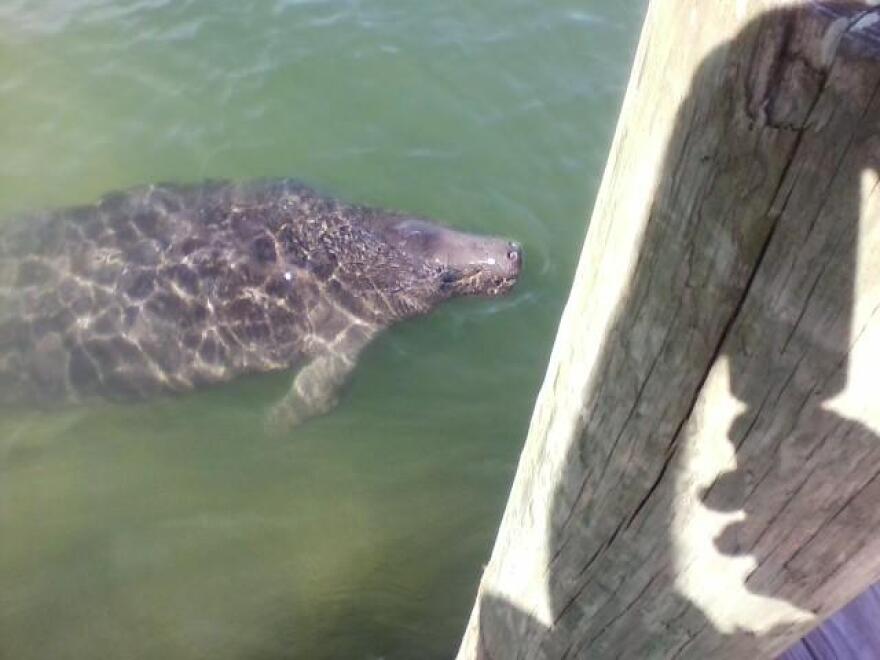You don’t normally associate manatees with North Carolina, but an increase in sightings have been reported this summer. We talk to a Carteret County man about his recent run in with a manatee.
Contributed video. Used with permission from Ken Banks.
You may have seen the article in Jacksonville Daily News about a recent close encounter with a manatee in eastern North Carolina. It may be a stretch for manatees to venture this far north. But for Carteret County resident Ken Banks, seeing is believing.
“It’s the first one I’ve ever seen. It’s a sight to behold, I’ll tell you that.”
Early Sunday morning, Banks received a call from his neighbor who was on a boat in a marina west of Cape Carteret.
“The manatee came up beside his boat and of course he called a couple of us that live around the marina. So we walked down to the docks and the manatee was actually just swimming around under the floats under the docks and I’m sure eating the algae, basically he was just meandering up and down the dock.”
Banks and several others gathered at the dock to marvel at the manatee for about an hour. He says it would go beneath the water for 15 minutes and then resurface.
“I could have reached down and touched him. He was a big one, probably 10 or 11 feet. Lots of barnacles, I guess they move so slow that barnacles can attach.”
Surprisingly, manatee sightings in coastal North Carolina are not terribly rare. In 2009, there were six sightings. That number doubled in 2010 and increased to 17 sightings in 2011. The upward trend hasn’t stopped. Research Technician with UNCW Marine Mammal Program Erin Cummings says there was a total of 30 manatee sightings in 2012.
“They’re reported to venture all the way up this way during the summer season all the way dating back to the 1930’s. There’s more and more people, we’re getting more and more sighting reports. So we think there are an increase in the number of manatees venturing up this way during the summer.”

Manatees grow up to 13 feet long and weigh more than 1,800 pounds. An endangered species, they’re usually found in the warm coastal waters of Florida. But during the summer, manatees have been spotted as far north as Connecticut. Scientists don’t know exactly what causes them to migrate so far from their native waters. Cummings says it may have something to do with competition for food sources.
“North Carolina has a lot of waterways and a lot of sea grasses. I know a lot of people are mapping out sea grasses in our state and other states to get an idea of the food abundance for them. But there are definitely food sources for them.”
According to the U.S. Fish and Wildlife Service, manatees may spend about 5 hours a day feeding, and may consume 4 to 9 percent of their body weight a day. It makes sense that they would migrate to areas, like the North Carolina coast where food sources are abundant.
Cumming says there have been 13 sightings so far this year coming from marinas, rivers, and the intercostal waterway. Although manatees prefer freshwater, some have actually been spotted swimming around piers at the Outer Banks this summer.
“A lot of sightings that we have go unreported. So we have to rely on people to actually know what number to call and actually report the sighting.”
June to October is the best chance to see a manatee in eastern North Carolina. That makes sense since the most recent sighting happened less than a week ago.
“I’ve not seen him since, and I don’t know that anyone else has.”
Banks, who saw the adult manatee off Bogue Sound on Sunday, said he didn’t report the encounter, hoping to keep onlookers at bay.
“It’s a private community, and I was a little fearful we might have a lot of boats coming in and actually endangering it or actually hitting it.”
Collisions with watercraft happen all too frequently. According to Defenders of Wildlife, more than 80 manatees are struck and killed from watercraft-related incidents each year. Cummings urging boaters to exercise caution when you know a manatee is in the area.
“Stay at a safe distance, don’t swim with it, don’t pet it, don’t feed it. Usually it’s looking for freshwater so we don’t encourage people not to give it freshwater when it’s in a marina because it will encourage the animal to stay in the area. We want it to do its usual thing and move around and return back to Florida. So admire it, take pictures of it. Just leave it be.”
In a month or two, most manatees will head south to warmer waters. Until then, Cummings is encouraging people to report their sightings. Scientists depend on the information to monitor manatee migration habits. Information on the location, the number of manatees spotted and a description of the animal is helpful for documentation.
If you happen on a manatee in Brunswick, New Hanover, Pender or Onslow Counties, contact any coastal North Carolina agency, and they report it to the Marine Mammal Program at UNCW where Cummings will add it to the manatee sighting database. You can also contact the program directly at 910-962-7266 or at cummingse@uncw.edu.



